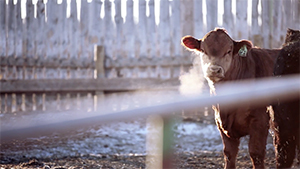Everything Old is New Again – Treating Chronic Mycoplasma
This article written by Dr. Reynold Bergen, BCRC Science Director, originally appeared in the October 2020 issue of Canadian Cattlemen magazine and is reprinted on the BCRC Blog with permission of the publisher.

Cattle were ideally created (or evolved) to consume and digest high fiber diets. Whoever (or whatever) was responsible for designing the rumen so elegantly probably should have paid more attention to the respiratory tract.
The design of the bovine respiratory tract makes it easy for BRD bacteria like Mannheimia, Pasteurella, Histophilus and Mycoplasma to move deep into the lung and find places to hide and makes it hard for the animal’s immune system to counterattack them. The bovine lung is so susceptible to infection and damage that it has been used as an “animal model” of chronic obstructive pulmonary disease (COPD) in humans.
This is a problem because cattle need a lot of oxygen. Cattle need nearly three times as much oxygen as a similar-sized horse just to stay awake and lie around. But the horse has nearly three times more lung capacity than the steer. Lung damage is one of the reasons that BRD hits cattle so hard, so fast.
Injectable macrolide antibiotics (e.g. Micotil, Hymatil, Tilcomed, Draxxin, Tylosin 200, Zactran, Zuprevo) have allowed veterinarians and feedlot operators to control and treat BRD effectively, because macrolides are preferentially transported to the lung tissue, not randomly distributed through the whole body like some other antibiotics. But BRD bacteria develop resistance when similar antibiotics are used year after year, or are used repeatedly in the same animal. The Western College of Veterinary Medicine’s Murray Jelinski and co-workers recently published a Beef Science Cluster study examining how resistance to macrolide antibiotics has changed over time in Mycoplasma bovis (Antimicrobial Sensitivity Testing of Mycoplasma bovis Isolates Derived From Western Canadian Feedlot Cattle; doi:10.3390/microorganisms8010124).
What They Did:
Veterinarians from three large feedlot practices collected deep nasopharyngeal samples from healthy cattle and BRD cases and tissue samples from the lungs and joints of cattle that died or were euthanized due to chronic BRD or arthritis at 31 commercial feedlots in Western Canada between 2006 and 2018. Mycoplasma was cultured, isolated and tested for resistance to a variety of macrolide antibiotics. Antibiotic resistance was compared between animal type (healthy, sick or dead), and changes in antibiotic resistance over time were examined.
What They Learned:
Macrolide resistance was highest in Mycoplasma from cattle that died or were euthanized in the chronic pen. For example, Draxxin had the lowest level of macrolide resistance (84%) in Mycoplasma from mortalities. These cattle had typically received and failed to respond to repeated antibiotic treatments, which strongly favored the survival of resistant bacteria. Macrolide resistance was intermediate in sick cattle. These were also likely treated with macrolides at least once, which would also favor the survival of resistant bacteria. Mycoplasma from healthy cattle had the lowest level of macrolide resistance, but resistance was still surprisingly high. For example, Draxxin resistance averaged 30% in Mycoplasma from healthy cattle. Over half of the healthy cattle were sampled on arrival, suggesting that they likely arrived at the feedlot carrying macrolide resistance.
Micotil was registered in Canada in 1990, long before the first samples were collected in this study in 1990. But Draxxin (fall 2007), Zactran (March 2010) and Zuprevo (June 2012) were all registered after the study started. So Mycoplasma from cattle that died in 2007-2008 were compared to samples from 2017-18 to see how resistance changed as more macrolide antibiotics became available. Macrolide resistance was significantly higher in Mycoplasma isolated from cattle that died in 2017-18 compared to those that died in 2007-08. Resistance was also highly correlated among the different macrolides; Mycoplasma isolates that were resistant to one macrolide antibiotic were usually resistant to the other macrolides as well.
What it Means:
Many antibiotics attack the bacterial cell wall. Mycoplasma doesn’t have a cell wall, so those antibiotics can’t hurt it. Macrolide antibiotics can attack Mycoplasma, so they were a miracle drug when they were introduced. But low levels of naturally macrolide resistant Mycoplasma were already circulating before macrolides appeared. Those resistant Mycoplasma were very rare at the time but were the only ones that survived when macrolide use became widespread. Over time, resistant Mycoplasma became more common, and macrolides have become less miraculous.
The same thing can happen in reverse. Some antibiotic resistance mechanisms are metabolically costly for bacteria to maintain. Maintaining resistance to antibiotics that aren’t being used is like wearing a suit of armor during peacetime – it’s a lot of unnecessary work. In that event, non-resistant bacteria can out-compete resistant bacteria, and resistance to those antibiotics becomes less common over time. Rotating classes of antibiotics may help maintain their effectiveness in the long run. In fact, the antibiotic susceptibility results from this study suggest that oxytetracycline may have been a better choice for treating Mycoplasma than any of the macrolides in recent years. Actual BRD treatment outcomes under different antibiotic treatment regimes would be needed to confirm this.
Feedlots are under pressure to use antibiotics responsibly. But calves that are properly vaccinated, in a good nutritional state and weaned for a month or more before leaving the ranch will also contribute to prudent antibiotic use.
The Beef Cattle Research Council is funded by the Canadian Beef Cattle Check-Off. The BCRC partners with Agriculture and Agri-Food Canada, provincial beef industry groups and governments to advance research and technology transfer supporting the Canadian beef industry’s vision to be recognized as a preferred supplier of healthy, high quality beef, cattle and genetics.
Click here to subscribe to the BCRC Blog and receive email notifications when new content is posted.
The sharing or reprinting of BCRC Blog articles is typically welcome and encouraged, however this article requires permission of the original publisher.
We welcome your questions, comments and suggestions. Contact us directly or generate public discussion by posting your thoughts below.